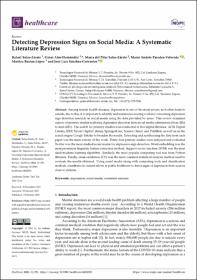Mostrar el registro sencillo del ítem
Detecting Depression Signs on Social Media: A Systematic Literature Review
| dc.contributor.author | Salas-Zárate, Rafael | |
| dc.contributor.author | Alor-Hernández, Giner | |
| dc.contributor.author | Salas-Zárate, María del Pilar | |
| dc.contributor.author | Paredes-Valverde, Mario Andres | |
| dc.contributor.author | Bustos-López, Maritza | |
| dc.contributor.author | Sánchez-Cervantes, José Luis | |
| dc.date.accessioned | 2022-06-29T16:53:13Z | |
| dc.date.available | 2022-06-29T16:53:13Z | |
| dc.date.issued | 2022-02-01 | |
| dc.identifier.citation | Salas-Zárate, R.; Alor-Hernández, G.; Salas-Zárate, M.d.P.; Paredes-Valverde, M.A.; Bustos-López, M.; Sánchez-Cervantes, J.L. Detecting Depression Signs on Social Media: A Systematic Literature Review. Healthcare 2022, 10, 291. https://doi.org/10.3390/healthcare10020291 | es |
| dc.identifier.issn | 2227-9032 | |
| dc.identifier.other | https://doi.org/10.3390/healthcare10020291 | |
| dc.identifier.uri | http://repositorios.orizaba.tecnm.mx:8080/xmlui/handle/123456789/594 | |
| dc.description | Among mental health diseases, depression is one of the most severe, as it often leads to suicide; due to this, it is important to identify and summarize existing evidence concerning depression sign detection research on social media using the data provided by users. This review examines aspects of primary studies exploring depression detection from social media submissions (from 2016 to mid-2021). The search for primary studies was conducted in five digital libraries: ACM Digital Library, IEEE Xplore Digital Library, SpringerLink, Science Direct, and PubMed, as well as on the search engine Google Scholar to broaden the results. Extracting and synthesizing the data from each paper was the main activity of this work. Thirty-four primary studies were analyzed and evaluated. Twitter was the most studied social media for depression sign detection. Word embedding was the most prominent linguistic feature extraction method. Support vector machine (SVM) was the most used machine-learning algorithm. Similarly, the most popular computing tool was from Python libraries. Finally, cross-validation (CV) was the most common statistical analysis method used to evaluate the results obtained. Using social media along with computing tools and classification methods contributes to current efforts in public healthcare to detect signs of depression from sources close to patients | es |
| dc.description.abstract | Among mental health diseases, depression is one of the most severe, as it often leads to suicide; due to this, it is important to identify and summarize existing evidence concerning depression sign detection research on social media using the data provided by users. This review examines aspects of primary studies exploring depression detection from social media submissions (from 2016 to mid-2021). The search for primary studies was conducted in five digital libraries: ACM Digital Library, IEEE Xplore Digital Library, SpringerLink, Science Direct, and PubMed, as well as on the search engine Google Scholar to broaden the results. Extracting and synthesizing the data from each paper was the main activity of this work. Thirty-four primary studies were analyzed and evaluated. Twitter was the most studied social media for depression sign detection. Word embedding was the most prominent linguistic feature extraction method. Support vector machine (SVM) was the most used machine-learning algorithm. Similarly, the most popular computing tool was from Python libraries. Finally, cross-validation (CV) was the most common statistical analysis method used to evaluate the results obtained. Using social media along with computing tools and classification methods contributes to current efforts in public healthcare to detect signs of depression from sources close to patients | es |
| dc.description.sponsorship | CONACYT, TECNM, PRODEP | es |
| dc.language.iso | en_US | es |
| dc.publisher | MDPI Publishing | es |
| dc.relation.ispartofseries | Healthcare; | |
| dc.subject | Social Media | es |
| dc.subject | Depression Signs | es |
| dc.subject | Systematic Literature Review | es |
| dc.title | Detecting Depression Signs on Social Media: A Systematic Literature Review | es |
| dc.type | Article | es |
Ficheros en el ítem
Este ítem aparece en la(s) siguiente(s) colección(ones)
-
Artículos (DCI) [72]



